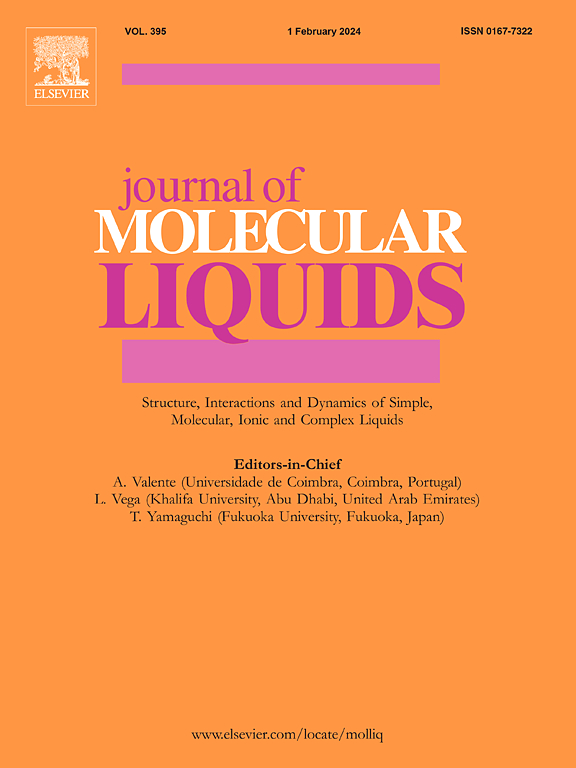Experimental and theoretical exploration of intermolecular interactions in butyl acrylate + benzene, + toluene, + o-xylene, + m-xylene, + p-xylene, and + mesitylene binary mixtures at ambient temperatures: Ultrasonic and viscometric methods
IF 5.3
2区 化学
Q2 CHEMISTRY, PHYSICAL
引用次数: 0
Abstract
The speeds of sound, u and viscosities, η of the binary mixtures of butyl acrylate with benzene, toluene, o-xylene, m-xylene, p-xylene, and mesitylene across the full mole fraction range were measured at ambient temperatures and pressure, p = 100 kPa. The experimental data are correlated by means of Jouyban-Acree model to represents the composition and temperature dependence of these physical properties. Using the measured data, various parameters, viz., excess isentropic compressibilities, excess speeds of sound, excess molar isentropic compressibilities, and deviations in viscosity were evaluated. The partial molar isentropic compressibilities and excess partial molar isentropic compressibilities of the constituents over whole composition range; and at infinite dilution are calculated. The variation of these parameters has been interpreted in relation to the intermolecular interactions in these mixtures. The results specified the presence of weak interactions between unlike molecules, the interactions follow the order: benzene > toluene > p-xylene > m-xylene > o-xylene > mesitylene. The extent of interactions depends on the number and position of the methyl groups substituted to benzene ring in these aromatic hydrocarbons. The speeds of sound were theoretically calculated by means of various theories/relations and the viscosities of these mixtures were correlated by means of several empirical and semi-empirical models and the outcomes are compared with experimental data. The relative applicability of these theories/relations has been discussed.

求助全文
约1分钟内获得全文
求助全文
来源期刊

Journal of Molecular Liquids
化学-物理:原子、分子和化学物理
CiteScore
10.30
自引率
16.70%
发文量
2597
审稿时长
78 days
期刊介绍:
The journal includes papers in the following areas:
– Simple organic liquids and mixtures
– Ionic liquids
– Surfactant solutions (including micelles and vesicles) and liquid interfaces
– Colloidal solutions and nanoparticles
– Thermotropic and lyotropic liquid crystals
– Ferrofluids
– Water, aqueous solutions and other hydrogen-bonded liquids
– Lubricants, polymer solutions and melts
– Molten metals and salts
– Phase transitions and critical phenomena in liquids and confined fluids
– Self assembly in complex liquids.– Biomolecules in solution
The emphasis is on the molecular (or microscopic) understanding of particular liquids or liquid systems, especially concerning structure, dynamics and intermolecular forces. The experimental techniques used may include:
– Conventional spectroscopy (mid-IR and far-IR, Raman, NMR, etc.)
– Non-linear optics and time resolved spectroscopy (psec, fsec, asec, ISRS, etc.)
– Light scattering (Rayleigh, Brillouin, PCS, etc.)
– Dielectric relaxation
– X-ray and neutron scattering and diffraction.
Experimental studies, computer simulations (MD or MC) and analytical theory will be considered for publication; papers just reporting experimental results that do not contribute to the understanding of the fundamentals of molecular and ionic liquids will not be accepted. Only papers of a non-routine nature and advancing the field will be considered for publication.
 求助内容:
求助内容: 应助结果提醒方式:
应助结果提醒方式:


